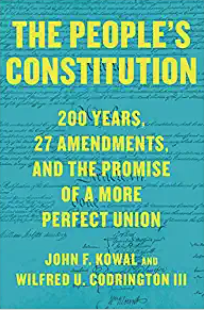||| FROM THE BRENNAN CENTER |||
That’s obvious, we think: it was crafted by 55 men in powdered wigs who met in Philadelphia over the summer of 1787 with the charge of “establishing in these states a firm national government.” But more than 40 percent of the Constitution was actually written after 1787 in a series of 27 amendments adopted over the course of two centuries amid some of the most colorful, contested, and controversial battles in American life. While the Framers get all the credit for the nation’s charter, the American people deserve to share the byline.

Today, with the publication of The People’s Constitution by the Brennan Center’s own John Kowal and Wilfred Codrington, this history comes vividly to life in a book Publishers Weekly calls “a fresh and invigorating take on the history of American democracy.”
The book tells the 233-year story of how the American people have taken an imperfect Constitution — a document both profoundly visionary and fundamentally flawed — and made it more democratic, more inclusive, and more suited to the needs of a changing country through the Article V amending process. Some of these additions have wrought profound changes to America’s fundamental law: safeguarding individual liberties, ending slavery, expanding access to the ballot, upholding equality. Others are best described as technical fixes.
But when we consider the 27 amendments as a whole, it is no exaggeration to say that much of what we consider the very heart of our national charter — from its protections for free speech and religion to its guarantees of due process and equal protection of the laws — come from these periodic upgrades to the Framers’ beta version of our national charter.
This lively and accessible history explores an intriguing pattern. In recurring cycles, Americans have added several new amendments in the span of a few years’ time, prodded by powerful social movements. Just as predictably, these periods of ferment are followed by decades-long dry spells. In this way, our Constitution has been revitalized and its promise renewed in four distinct waves of Constitutional change.
- Twelve Founding Era amendments (1789–1804) fixed glitches and omissions in the original text, including the lack of comprehensive protection for individual rights.
- Three Reconstruction amendments (1865–1870) promised a “second founding” after the cataclysm of the Civil War, guaranteeing equal citizenship and voting rights to newly freed African-American men while imposing significant new limits on state governments, particularly in the South.
- Four Progressive Era amendments (1909–1920) embodied the modernizing zeal of the age: authorizing the income tax, providing for the popular election of senators, extending the franchise to women, and launching the misguided experiment of Prohibition.
- And four Civil Rights Era amendments (1960–1971) further expanded voting rights while updating presidential succession amid the doomsday fears of the nuclear age.
In these polarized times, it may seem impossible to imagine forging the broad consensus needed to amend the Constitution anytime soon. And yet, as Kowal and Codrington explore, when our Constitution seems unable to adapt to changing times, when political gridlock and a retrograde Supreme Court stand in the way of needed reforms, the next wave of constitutional change may already be building.
Which reforms will rise to the top of the agenda? Will we finally abolish the Electoral College and provide meaningful protection for every citizen’s right to vote? Will far-right activists succeed in summoning a new constitutional convention to radically restrict the size and power of the federal government?
For more on this rigorous yet intimate history, check out New Press’s website. You won’t be sorry.
**If you are reading theOrcasonian for free, thank your fellow islanders. If you would like to support theOrcasonian CLICK HERE to set your modestly-priced, voluntary subscription. Otherwise, no worries; we’re happy to share with you.**





